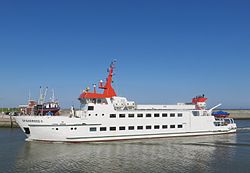Spiekeroog II
|
2015 in Neuharlingersiel
|
||||||||||||||||||
|
||||||||||||||||||
|
||||||||||||||||||
|
||||||||||||||||||
|
||||||||||||||||||
|
||||||||||||||||||
|
||||||||||||||||||
In addition to the Spiekeroog I and the Spiekeroog IV, the Spiekeroog II is one of the ferry ships used between the North Sea island of Spiekeroog and Neuharlingersiel . The ship belongs to the Nordseebad Spiekeroog GmbH ; it was bought in 1991 and put into operation when the old Spiekeroog II was taken out of service.
The ship
The ship was built under construction number 166 at the Martin Janssen shipyard and machine factory in Leer . The keel was laid on December 1, 1980, the launch on March 16 and completion in April 1981. The ship is propelled by two diesel engines , each with an output of 445 kW acting on the two fixed propellers of the ship. The ship also has a bow thruster.
The ferry is stationed on Spiekeroog and usually runs one or two times a day to Neuharlingersiel and back. In addition to the travelers' luggage, which are transported in containers on the forecastle, mail is also transported.
The Spiekeroog II has three decks accessible to passengers, including the main deck with the main saloon and a kiosk at the level of the aft deck, the upper deck with the upper saloon and a large number of outdoor seating above.
The Spiekeroog II is approved for mudflat and coastal travel. The ship was not built specifically for its area of operation and is much more powerful and seaworthy compared to the two ferries Spiekeroog I and Spiekeroog III . The higher seaworthiness results mainly from the significantly higher bow , the more powerful engines and the capacity for ballast water . Until 2008, the Spiekeroog II was occasionally used for day trips to Helgoland. Since the lower windows would have had to be converted to continue these journeys for safety reasons, these journeys were discontinued.
history
From 1981 the ship sailed under the names Hannover and Stadt Neustadt in Sweden. In 1991 the ship was bought by Nordseebad Spiekeroog GmbH.
On March 7, 2003 the Spiekeroog II rammed the Ems barrier in Gandersum in thick fog and was badly damaged. After repairs were carried out at the Diedrich shipyard in Oldersum, the Spiekeroog II was able to return to regular service in Spiekeroog in April 2003.
After new, heavier machines were installed in 2008, the number of passengers had to be reduced from 700 to 690.
Predecessor ships
There were already two ships with the same name:
- The current Jens Albrecht III : built in 1935 as Baltrum II , operated from 1958 to 1985 as Spiekeroog II
- The current Harle Kurier : built in 1971 as Langeoog II , operated from 1985 to 1991 as Spiekeroog II
See also
Web links
- Spiekeroog II on the website of the island of Spiekeroog
- Live webcam on the berth of the Spiekeroog II
- older pictures of the Spiekeroog II (1981)
- Inselfaehren.de Private website with information and pictures of the Spiekeroog II (1981)
Individual evidence
- ^ Emergencies at sea 2003 ( Memento from May 16, 2008 in the Internet Archive )
